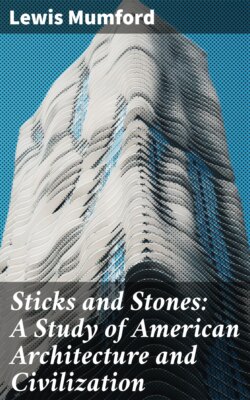Читать книгу Sticks and Stones: A Study of American Architecture and Civilization - Lewis Mumford - Страница 9
На сайте Литреса книга снята с продажи.
I
ОглавлениеTable of Contents
The forces that undermined the medieval civilization of Europe sapped the vitality from the little centers it had deposited in America. What happened in the course of three or four centuries in Europe took scarcely a hundred years on this side of the Atlantic.
Economically and culturally, the village community had been pretty well self-contained; it scraped along on its immediate resources, and if it could not purchase for itself the “best of everything” it at least made the most of what it had. In every detail of house construction, from the setting of fireplaces to the slope of the roof, there were local peculiarities which distinguished not merely the Dutch settlements from the English, but which even characterized several settlements in Rhode Island that were scarcely a day’s tramp apart. The limitation of materials, and the carpenter’s profound ignorance of “style” made for freedom and diversity. It remained for the eighteenth century to erect a single canon of taste.
With the end of the seventeenth century the economic basis of provincial life shifted from the farm to the sea. This change had the same effect upon New England, where the village-community proper alone had flourished, that fur-trading had had upon New York: it broke up the internal unity of the village by giving separate individuals the opportunity by what was literally a “lucky haul,” to achieve a position of financial superiority. Fishermen are the miners of the water. Instead of the long, watchful care that the farmer must exercise from planting time to harvest, fishing demands a sharp eye and a quick, hard stroke of work; and since what the Germans call Sitzfleisch is not one of the primary qualities of a free lad, it is no wonder that the sea weaned the young folks of New England away from the drudgeries of its boulder-strewn farms. With fishing, trading, and building wooden vessels for sale in foreign ports, riches poured into maritime New England; and what followed scarcely needs an explanation.
These villages ceased to be communities of farmers, working the land and standing squarely on their own soil: they became commercial towns which, instead of trading for a living, simply lived for trade. With this change, castes arose; first, the division between the poor and the rich, and then between craftsmen and merchants, between the independent workers and the menials. The common concerns of all the townsfolk took second rank: the privileges of the great landlords and merchants warped the development of the community. Boston, by the middle of the eighteenth century, was rich in public buildings, including four schoolhouses, seventeen churches, a Town House, a Province House, and Faneuil Hall—a pretty large collection for a town whose twenty thousand inhabitants would scarcely fill a single block of tenements in the Bronx. But by this time a thousand inhabitants were set down as poor, and an almshouse and a workhouse had been provided for them.
With the rise of the merchant class, the industrial guild began to weaken, as it had weakened in Europe during the Renaissance. For about a hundred years the carpenter-builder continued to remain on the scene, and work in his forthright and painstaking and honest manner; but in the middle of the eighteenth century he was joined, for the first time, by the professional architect, the first one being probably Peter Harrison, who designed the Redwood Library, which still stands in Newport. Under competition with architects and amateurs of taste, the carpenter-builder lost his position as an independent craftsman, building intelligently for his equals: he was forced to meet the swift, corrosive influences brought in from foreign lands by men who had visited the ports of the world; and he must set his sails in order to catch the new winds of fashion.
What were these winds, and what effect did they have upon the architecture of the time?
Most of the influences that came by way of trade affected only the accent of architecture; the language remained a homely vernacular. In the middle of the eighteenth century China sent over wallpaper; and in the Metropolitan Museum there is an American lacquered cabinet dated as early as 1700, decorated with obscure little Chinese figures in gilded gesso. “China” itself came in to take the place of pewter and earthenware in the finer houses; while in the gardens of the great manors, pavilions and pagodas, done more or less in the Chinese manner, were fashionable. Even Thomas Jefferson, with his impeccably classical taste, designed such a pavilion for Monticello before the Revolution.
This specific Chinese influence was part of that large, eclectic Oriental influence of the eighteenth century. The cultural spirit that produced Montesquieu’s Lettres Persanes also led to the translation of the Chinese and Persian and Sanskrit classics, and by a more direct route brought home Turkish dressing-gowns, turbans, and slippers to Boston merchants. In Copley’s painting of Nicholas Boylston, in 1767, these Turkish ornaments rise comically against the suggestion of a Corinthian pillar in the background; and this pillar recalls to us the principal influence of the time—that of classic civilization. This influence entered America first as a motif in decoration, and passed out only after it had become a dominating motive in life.
